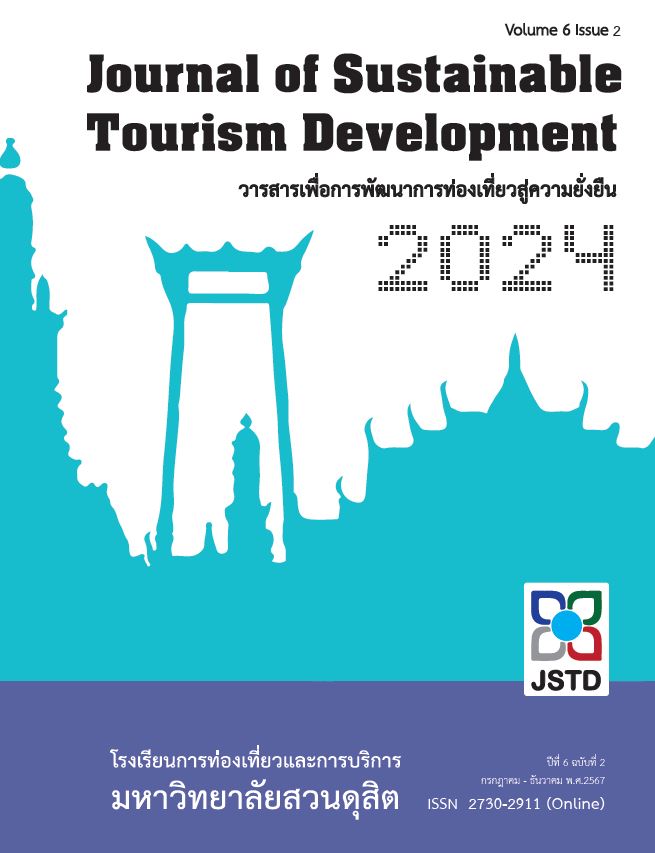Strengthening Tourism through Coffee Shop Management: A Case Study of Phayao, Thailand
Main Article Content
Abstract
This study aims to examine coffee shop management strategies to promote tourism in Phayao Province, focusing on two main dimensions: 1) understanding the behaviors and preferences of Thai tourists, based on a sample of 400 individuals selected via Accidental Sampling and surveyed using a validated and reliable questionnaire, analyzed with descriptive statistics, including frequency, percentage, mean, and standard deviation; and 2) exploring the perspectives of 20 coffee shop operators around Kwan Phayao through semi-structured interviews, analyzed using content analysis. The findings reveal that most tourists are male (46.25%), aged 25–29 years (36.25%), and employed in the private sector (53.5%). Tourists prefer coffee shops with unique local characteristics (47.25%) and those specializing in specific coffee beans (65%). The highest satisfaction levels were recorded for the variety of beverages and pastries (Mean = 3.97, SD = 0.862), followed by certified or award-winning baristas (Mean = 3.89, SD = 0.821) and the overall coffee shop atmosphere (mean = 3.86, SD = 0.793).From the operators’ perspective, effective coffee shop management involves creating a welcoming environment with proper ventilation and functional layout, positioning the shop as a distinctive tourist destination with Instagrammable features, adopting environmentally friendly practices, leveraging social media marketing, supporting the development of a Phayao coffee trail, and enhancing local coffee roasting standards. This research proposes strategies for strengthening coffee shops in two dimensions: improving coffee shop operations and fostering coffee tourism to promote Phayao as a unique tourism destination.
Article Details

This work is licensed under a Creative Commons Attribution-NonCommercial-NoDerivatives 4.0 International License.
ลิขสิทธิ์ต้นฉบับที่ได้รับการตีพิมพ์ในวารสารเพื่อการพัฒนาการท่องเที่ยวสู่ความยั่งยืน ถือเป็นกรรมสิทธิ์ของโรงเรียนการท่องเที่ยวและการบริการ มหาวิทยาลัยสวนดุสิต ห้ามผู้ใดนำข้อความทั้งหมดหรือบางส่วนไปพิมพ์ซ้ำ เว้นแต่จะได้รับอนุญาตอย่างเป็นลายลักษณ์อักษรจากโรงเรียนการท่องเที่ยวและการบริการ มหาวิทยาลัยสวนดุสิต นอกจากนี้ เนื้อหาที่ปรากฎในบทความเป็นความรับผิดชอบของผู้เขียน ทั้งนี้ไม่รวมความผิดพลาดอันเกิดจากเทคนิคการพิมพ์
References
เอกสารอ้างอิง (ภาษาอังกฤษ)
Fayol, H. (1916). Administration Industrielle et Generale. Bulletin de la Societe de l’Industrie
Minerale, Fifth Series, 10(3), 5–162.
Kotler, P., Bowen, J. T., & Makens, J. C. (2006). Marketing for Hospitality and Tourism
(4th ed.). Pearson Education International.
Kritawanich, A. (2021). Community identity communication for Akha Pang Khon coffee
packaging design to promote coffee tourism. Rajapark Journal, 15(43), 197–210.
Lalhalert, P., & Chaidirek, P. (2018). Marketing mix affecting the consumers’ decision in
drinking fresh coffee in the Provincial Tourism in the Gulf of Thailand. Journal of Management Science Nakhon Pathom Rajabhat University, 3(1), 1–11.
Madhyamapurush, W., & Jittithavorn, C. (2020). Tourism marketing for sustainable development in
Phayao Province, Thailand. International Journal of Hospitality & Tourism Management, 4(2), 15–20.
Raktida, S. (2018). The segmentation of coffee drinkers by using lifestyle and the perceived
value of coffee shop: A case study of international tourists in Chiang Mai Province. FEU Academic Review Journal, 12(2), 199–216.
Tatnormjit, T., Nachai, P., & Nachai, S. (2022). Development guide for the Thai restaurant
business ASEAN standards in Muang District Nakhon Phanom. PannaPanithan Journal, 7(2), 243-254.
Thongkamnush, T., Chuapung, B., & Sakulrat, T. (2022). Luxury service experience guidelines
of coffee tourism in Ayutthaya Province. Journal of Buddhist Anthropology, 7(3), 190–206.
